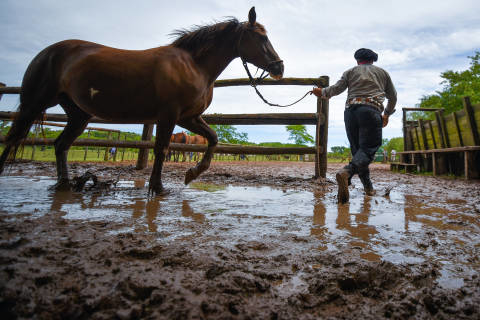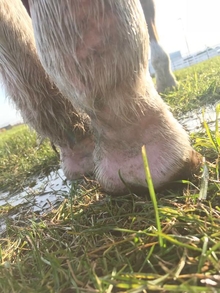Quick facts
- Taking preventative measures to manage mud on the farm can save time and keep horses healthy.
- Constructing high-traffic pads with geotextile fabric and other materials is the best way to keep areas well drained during muddy seasons.
- Alternative footing options and temporary drainage solutions may also be helpful, but have some downsides.
Throughout the year, horse owners work outside to care for their horses despite challenging weather. Whether it is rain, sleet or snow, precipitation eventually turns soil to mud and can create major hurdles for efficient horse care.
To best prepare for muddy conditions, plan to manage precipitation and construct permanent drainage solutions.
Permanent drainage solutions
Facility layout is a key first step to permanent drainage solutions. Place buildings, material storage, animal feeding areas and shelters on higher ground. These areas will dry faster as fluids flow to lower ground. An ideal slope is between four and six degrees.
In areas of heavy traffic where mud tends to accumulate, such as gates, laneways and dry lots, consider building a high-traffic pad. High-traffic pads improve drainage and provide stabilization through the use of multiple layers of permeable geotextile fabric and stones of various sizes.
Constructing a high-traffic pad
Site selection
To improve drainage, construct high-traffic pads in areas that have reduced or no vegetation or are compacted from frequent hoof traffic, such as dry lots and laneways.
- Plants can help reduce mud. A healthy stand of vegetation can take up moisture, anchor soil to prevent erosion and slow nutrient runoff.
- Compacted soil, such as from hoof traffic, has poor water infiltration, which means that liquids pool on the surface and runoff instead of soaking into the ground.
Build high-traffic pads within a dry lot, for example, under feeding areas, gates, shelters, lanes, etc. Due to cost, it’s rare that an entire dry lot will be constructed as a high-traffic pad. Rather, select specific areas within a dry lot with a maximum slope of six degrees to help ensure that footing does not wash away.
How to build a high-traffic pad
- Remove 8 inches of the topsoil, making sure that the base is level.
- Install a drainpipe parallel to the high-traffic pad.
- The pipe should be permeable to allow for water to enter and be directed towards a drainage ditch. Only include this step when there is an appropriate drainage point for water to go.
- For the drainpipe to work best, it should be encased in a permeable fabric and surrounded by gravel, similar to a French drain system. This will filter sediment and prevent blockage of the pipe.
- Install the first layer of geotextile fabric across the base of the pad.
- Use woven geotextile fabric as it is durable and permeable. This allows water to drain while providing a stable base.
- The high-traffic pad should align with the width of the geotextile fabric, 10 to 12 feet.
- Add 4 inches of crushed limestone sized 1.5 to 1.75 inches. Compact with a vibratory plate compactor.
- Install a second layer of geotextile fabric. This encourages drainage by keeping the layers separated.
- Top with a 4-inch layer of footing. Compact with a vibratory plate compactor.
- Use unwashed fine gravel, commonly called dirty pea gravel, but regional names vary.
- Crushed bluestone is also appropriate for a top layer of footing.
- When in doubt, consult an expert where you plan to purchase this material, they can direct you to a suitable product available in your region.
Alternative grid systems are also available for high-traffic pad construction. If you plan to use these types of systems, consult the manufacturing company for installation guidelines.
Alternative footing options
Although alternative footing options are available for the top layer of high traffic pads, we recommend fine-crushed gravel as this material is more resistant to breakdown and requires less frequent refreshing.
- Sand is also durable but may wash away under heavy rain if kickboards aren’t installed. If hay and feed aren’t fed in elevated feeders, horses are at an increased risk of sand colic.
- Wood-based products breakdown quickly and, if not removed or managed correctly, can become mud.
Maintenance
Maintaining your high-traffic pad is as important as proper construction.
- Pick manure frequently to prevent nutrient runoff and creating more mud, and to reduce bacteria in the environment that may cause thrush, scratches (pastern dermatitis) and cellulitis.
- Rake and refresh the high-traffic pad as needed to maintain a level surface.
Temporary drainage solutions
In the event that temporary, or emergency, mud management is required, dry spots can be constructed by adding gravel, dirt or sand to paddocks.
- Only use these solutions when necessary as they lack the structure of high-traffic pads and may result in erosion and nutrient runoff.
- Avoid using footing materials that readily break down such as straw, hay and wood chips.
Other rain and snow management
- Install gutters on all buildings and use drainage ditches and swales to direct rain, sleet and snow towards these areas.
- Create a plan for piling snow to ensure that you can accommodate snowmelt in the spring. Make sure that rainfall, snowfall and melting snow doesn’t drain into manure piles as this can create nutrient runoff.
- Always store manure on a non-porous pad, such as concrete, and remove it regularly, following state and local codes.
Horse health concerns in muddy environments
Horses should be checked daily for signs of thrush, pastern dermatitis and cellulitis. These conditions thrive in wet environments and can be worsened by the presence of bacteria. Removing manure daily can help reduce bacteria.
Pastern dermatitis, commonly referred to as "scratches" is a skin condition that affects the back of the pastern and heel region of the horse.
- Signs include raw, irritated skin and in severe cases, sores may form.
- Mild cases require daily cleaning, drying and applying a topical treatment.
- Clipping hair from the inflamed region may help keep the area clean.
- Horses should be moved to a dry environment.
More severe cases may require veterinary prescribed topical cream containing antibiotics, antifungal agents and dexamethasone to reduce swelling.
Cellulitis is caused by bacterial infection within the connective tissue layer underneath the skin and commonly occurs in the lower limbs.
- Signs include swelling that is hot and tender.
- Cleaning the limb, cold-hosing treatments and dosing with nonsteroidal anti-inflammatory drugs can help treat mild cases.
- In more serious cases, a fever may develop, swelling may spread up the limb, and horses may become lame.
If you suspect that your horse has cellulitis, consult your veterinarian immediately for a treatment plan.
Reviewed in 2024



